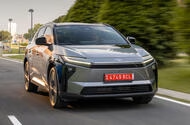Toyota has rolled out significant updates to the bZ4X, its mid-size electric SUV, aiming to address earlier criticisms and enhance its appeal in a competitive market. The bZ4X, often viewed as a challenger to the likes of the Tesla Model Y, faced a rocky start with delays, recalls, and concerns about battery performance in cold weather. But with this facelift, Toyota is clearly stepping up its game.
What’s New in the bZ4X?
The most noticeable changes are aesthetic. The front end has been revamped with sleeker headlights and glossy black wheel-arch trims, replacing the previous unpainted look. This fresh design not only modernizes the vehicle but also aligns it more closely with contemporary electric SUV trends.
Under the hood, the bZ4X has received a battery boost. The capacity has increased from 71.4 kWh to 73.1 kWh, thanks to the addition of eight new cells. This upgrade translates to a more impressive range, with the dual-motor version now offering up to 314 miles on a single charge. For those opting for the single-motor variant, the range jumps even higher to 354 miles, although wheel size can slightly affect these figures.
How Does It Drive?
Driving dynamics have also seen improvements. The dual-motor version now boasts an additional 124 horsepower, significantly enhancing its acceleration. The 0-62 mph time has dropped by 1.8 seconds, making it a brisk performer in its class. The single-motor version, while still adequate, remains more of a steady cruiser rather than a speed demon.
Toyota has also refined the bZ4X’s handling characteristics. The engineers have made adjustments to the chassis and suspension, enhancing ride comfort, particularly for rear passengers. The car strikes a balance between comfort and performance, avoiding the overly soft ride of some competitors while steering clear of the sporty stiffness found in others.
What About the Interior?
Inside, the bZ4X has undergone a thoughtful makeover. The previous glossy black center console has been replaced with a matte finish, now featuring two wireless charging pads—an upgrade that many will appreciate. The multimedia system, borrowed from the Lexus RZ, is more user-friendly, allowing for a seamless transition between the native interface and Apple CarPlay.
However, not all changes have been universally praised. While the new textured rubber dashboard adds a touch of durability, it also contributes to a rather monochromatic interior that some may find less inviting. Overall, the cabin remains spacious, with comfortable seating and decent legroom for rear passengers, though the boot space is merely adequate.
How Does It Compare on Range and Charging?
Range anxiety has been a hot topic for electric vehicle owners, and the bZ4X aims to alleviate some of those concerns. The WLTP range improvements are significant, and the vehicle now features a pre-conditioning function that helps maintain optimal charging speeds, even in colder conditions. The peak charging speed remains at 150 kW, which is competitive in its class.
Pricing and Market Position
While exact pricing details are still under wraps, estimates suggest the bZ4X will start around £40,000. Given its current positioning, it’s slightly more expensive than rivals like the Hyundai Ioniq 5 and Renault Scenic. Toyota’s cautious approach to electric vehicles has been evident, and while the bZ4X may not yet lead its class, these updates keep it relevant and practical for everyday use.
Final Thoughts
The updated bZ4X is a solid option for those looking for a reliable electric SUV. It may not be the most exciting choice on the market, but it offers a no-nonsense approach with practical features and improved performance. The big takeaway? The bZ4X isn’t about perfection—it’s about smarter adjustments. Start with one change this week, and you’ll likely spot the difference by month’s end.

